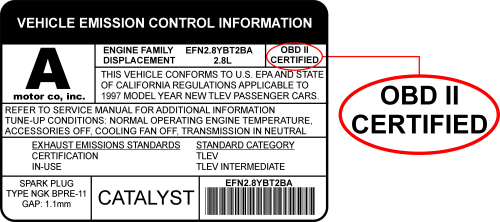|
All cars and light trucks built and sold in the United States after January 1, 1996 were required to be OBD II equipped. In general, this means all 1996 model year cars and light trucks are compliant, even if built in late 1995.
All gasoline vehicles manufactured in Europe were required to be OBD II compliant after January 1, 2001. Diesel vehicles were not required to be OBD II compliant until January 1, 2004.

All vehicles manufactured in Australia and New Zealand were required to be OBD II compliant after January 1, 2006. Some vehicles manufactured before this date are OBD II compliant, but this varies greatly between manufacturers and models.
Two factors will show if your vehicle is OBD II compliant:
1. There will be an OBD II connector, and
2. There will be a note on a sticker or nameplate under the hood stating "OBD II compliant" or "OBD II Certified".
The connector must be located within three feet of the driver's seat and must not require any tools to be revealed. Most are located under the steering column. If your OBD II port is not there, look under the dash and behind ashtrays.
Auto manufacturers had some leeway in the communications protocol they used to transmit parameters or PIDs, which are required by law to be uniform, to scanners. There are currently five different OBD II communications protocols in use: KWP, PWM, VPW, ISO 9141, and CAN.
As a rule of thumb, GM cars and light trucks use SAE J1850 VPW (Variable Pulse Width Modulation). Chrysler products and all European and most Asian imports use ISO 9141 circuitry. Fords use SAE J1850 PWM (Pulse Width Modulation) communication patterns.
There are some variations among captive imports such as the Cadillac Catera, a German Opel derivative, which uses the European ISO 9141 protocol.
On 1996 and later vehicles, you can tell which protocol is used by examining the OBD II connector:
J1850 VPW - The connector should have locations 2, 4, 5, and 16 populated, but not 10 populated.
ISO 9141-2 - The connector should have locations 4, 5, 7, 15, and 16 populated.
J1850 PWM - The connector should have locations 2, 4, 5, 10, and 16 populated.
CAN Bus - The connector should have locations 4, 5, 6, 14, and 16 populated.
ISO 14230 KWP - The connector should have locations 4, 5, 7, 15, 16 populated.
If your vehicle has this style connector, but does not have these pins populated, you probably have a pre-OBDII vehicle. To add some confusion, even having the connector with the contacts shown above is not a guarantee of OBD II compliance. This style connector has been seen on some pre-1996 vehicles which were not OBD II compliant.
Most vehicle manufacturers have switched over to CAN bus protocols since 2006.
|